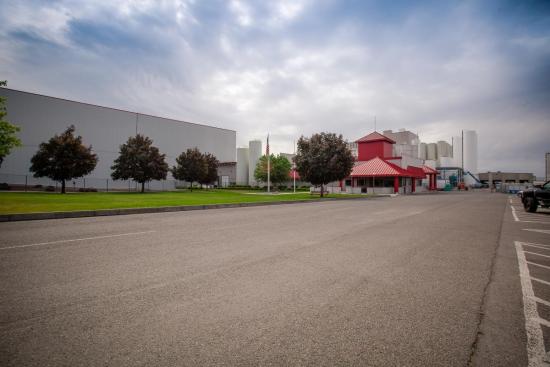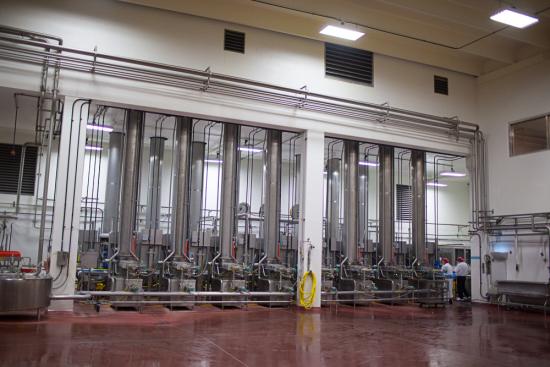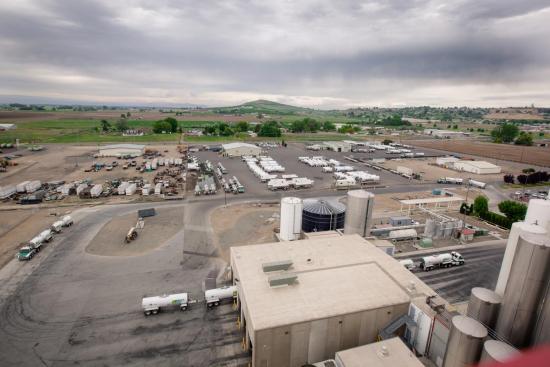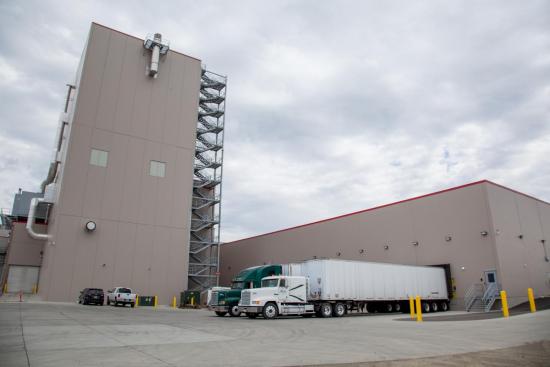Blower & Vacuum Best Practices interviewed Darigold’s Sunnyside Plant’s Technical Manager, Tom Rouleau

View of Darigold Sunnyside plant entrance
Good morning. Thank you for taking the time. To start things off, tell me a little about Darigold and your role there.
Darigold is a dairy marketing and processing cooperative producing over 8.4 billion pounds of milk a year. The cooperative also processes and distributes butter, cheese, fluid milk, cottage cheese and other cultured dairy products, as well as ingredients products for food manufacturers. These products are sold under the Darigold® brand name.
Currently, Darigold, Inc. has 11 processing facilities. It is a subsidiary of Northwest Dairy Association, which is owned by about 476 farm families. The members are farmers from Washington, Idaho, Oregon and Montana, where its manufacturing facilities are also located. Some plant locations include Seattle, Spokane, and Sunnyside in Washington, Portland in Oregon and Boise, Jerome, and Caldwell in Idaho.
Today, we manage one of the largest dairy co-ops in the United States. Our dairy farms and plants are truly awe-inspiring and efficient facilities. Our butter is made by one of America's only European-style vacuum churns, which makes butter with fewer air bubbles. Having the latest technology also helps Darigold produce less waste, fuel consumption and lower environmental impact.
I serve as the technical manager and my technical specialty is in cheese manufacturing. However, I get involved in all aspects of the plant operations, including sitting in with the energy team and helping drive that along, kind of like a facilitator role. That’s what I would say I do more than anything else, facilitation. I’ve been here at this plant for about 21 years.
We’ve made progress over the years, and it keeps getting better and better. Right on track with our energy goals and moving ahead.
What are the main applications of vacuum systems when it comes to your plant?
There are 16 Travainni vacuum pumps (one for each tower), handling the movement of cheese. In addition, there are 8 vacuum pumps being used for automated packaging of blocks as they exit the cheese towers. Finally, there are 3 large vacuum pumps, used for providing vacuum to the cheese blocks at sealing. All of this takes place in the tower area. The pumps for moving the cheese are water-sealed pumps; heat is dissipated through a re-circulating water system through a plate heat exchanger; heat is then exchanged through a closed loop to a cooling tower. Many of our vacuum pumps are Travainni in order to consolidate and keep parts consistent throughout the plant. All of them are stainless interior liquid ring pumps. Our evaporators use 20 hp pumps, where our cheese tower pumps are 7.5 hp. All other vacuum pumps are oil sealed and air-cooled.
There are 4 main applications for vacuum systems at Darigold.
1. Cheese towers - transport curd with air, and compression of the curd to blocks of cheese. Compression is attained by rapid restoration of atmospheric pressure from deep cycle vacuum.
2. Packaging operations
A. Opening of bags to insert product
B. Case packers to move corrugated into position
C. Sealing of individual blocks of cheese
3. Evaporators - lowering boiling point of fluids to remove water/concentration of milk and whey products. Along with this, is the use of MVR technology to recover heat from vapor removed.
4. Drying - transport powder output from drying to storage bins and to packaging operations.

View of cheese tower operation.
Let’s take it one step at a time then. Could you tell me about the cheese towers and how they operate?
Vacuum is applied at the top of the towers to put the entire unit under vacuum. The towers are roughly 15 feet tall. Cheese curds are drawn through a line, approximately 120 feet away, and fill the tower, which has a rectangular inner chamber. The cheese curds themselves are around 3/8” in diameter. There is a Lumenite probe level transmitter on the tower indicating the level of cheese. Once the tower is filled to the appropriate level, the valve allowing curds to enter the line shuts off.
Vacuum is retained on the entire unit for a period of time and starts to build up. The amount of time and amount of vacuum is programmed to drive different results dependent upon the type of cheese, process flow and other parameters. This can be as high as 20 inches of vacuum.
Upon completion of the vacuum cycle, the vent valves on top of the tower open quickly to allow the entry of atmospheric air. This sudden entry of air creates pressure differential, compressing the curd into a solid column 15’ long (the size of the tower).
A guillotine is located at the bottom of the column, opening up to release the column of cheese. The process works like an extrusion, and drops the cheese down onto a plate. We call this an elevator. It lowers the entire stick to a pre-determined depth, cuts it off with the guillotine, starting the cycle over again. The blocks are about 14.5 inches in length and right around 11 inches in width, typically weighing 42 to 43 lb. Above the guillotine the vacuum process repeats the cycle to maintain continuous operations.
Do packaging and sealing play a role during this process?
Shortly after, yes. While the column of cheese is being cut into blocks, an automatic bagger at the base of the cheese tower installs a cheese bag. An auto-bagger utilizing a separate vacuum pump opens the bag. While the guillotine is holding the block of cheese, we then introduce the bag on the chute just outside the tower. Another cylinder pushes the cheese block into the bag. An interesting side note to this is the original autobagger design included the use of Venturi valves to create the vacuum using compressed air. We evaluated energy consumption necessary to create the vacuum, and found we were able to provide more reliable vacuum while supplying the vacuum needs for two autobaggers at approximately ¼ the energy requirement, using a single small vacuum pump.
The block continues down a conveyor where it is prepared for sealing. Three blocks at a time enter a chamber. The chamber closes over the blocks and beings to develop vacuum. The pumps we use are Busch SV-1025-C-000-IKZZ 75 hp. We are looking for 30mbar vacuum to be achieved and a cycle time of about 25 seconds to keep up with production capacity. Once maximum vacuum is attained, a seal bar then applies heat to fuse the bag together. The chamber is then vented slowly. When the cycle completes, the lid on the chamber opens and allows the vacuum-sealed blocks to release. The blocks then travel to corrugated case packers.

Overview of the Sunnyside plant looking towards milk receiving operation from top of dryer building.
How is vacuum used in the evaporator process of your milk and whey products?
The concept is simple, we are trying to boil water off while preserving the product. As we lower the atmospheric pressure, the boiling point reduces, allowing us to boil it at a much lower temperature. This allows us to not cook the proteins in the milk or the whey powder.
The evaporator is a series of tubes pumping steam and hot water through them, boiling the milk. Steam generates off of the boiling milk and this is where energy conservation takes part, as this steam has energy value. The steam sucks over toward the vacuum pump. Here, a separator is located allowing us to condense the vapors.
We condense the vapors by means of a very large 500 hp turbo fan, creating pressure. You’re taking steam vapors, going from a low-pressure state to a high-pressure state, and turning them back into a liquid. That liquid is then reintroduced back into the series of tubes for reheating, increasing efficiency. Now, you don’t require makeup steam going into the process. The vacuum is typically 23-24” Hg., using 20 hp Travainni liquid ring pumps. The turbofans for mechanical vapor recompression are specialized fans manufactured by Schiele in Germany; with an oil cooled shaft and professionally balanced.
In addition, we also use vacuum to transport milk powder from our dryer to storage bins. This is an important consideration as the atmosphere of our drying plant is tightly controlled, and the use of traditional blowers could result in the addition of moisture and other contaminants to the powder.

View of new dryer building at south end of plant.
Is addressing vacuum leaks similar to addressing compressed air leaks?
It is a relatively similar process, albeit slightly more difficult. Air leaks will make a lot of noise, the vacuum leak will also make a lot of noise, but there is already so much ambient noise to begin with. We utilize the same bleed down test one might use on a compressor. You shut everything off, let it bleed off, and time it. With a vacuum pump you get the whole system under vacuum, shut off the pump, and identify how long it takes to bleed off the vacuum. Very similar process.
With our evaporators we can fill up the whole system with water, and let it leak out. It’s easy to see a leak coming out, but it’s very difficult to see one coming in. This necessitates a fair amount of downtime, but we’ve had to do it on occasion due to a severe problem. After many years of operation, it is not unheard of to develop cracks in the metal. This eventually leads to leaks in the ducts due to heating and expansion. In order to detect and/or avoid leaks, all the pieces of the puzzle have to be looked at and monitored.
- Gasket changes
- Daily monitoring of operational conditions
- How many vacuum pumps are running?
- What level of vacuum?
- How much steam load?
Leak detection is very much an investment coming with the technology. We do have a sonic listening device for evaluation of vacuum systems. We are looking at electronic vacuum sensors on our cheese towers, as an optimizational and operational tool to standardize each unit. This would also allow us to identify how much bleed by we have.
Take our bag sealers for our cheese as an example. They are essentially a large seal and meal type of device where we put 40 lb blocks in, three at a time. A clamshell comes down, with big Busch pumps driving the vacuum. When testing we take it down to 30 millibar, to obtain a solid vacuum level. Those have electronic gauges on them for monitoring.
Lastly, our turbo fans are a huge factor when it comes to leak detection. We have these very large fans with 500 hp motors for condensing vapors. Any kind of vacuum leak on those can really increase energy consumption. It will cause us to generate less vacuum inside the evaporator. This raises the boiling point of our product, so now you are adding more steam to heat it, jeopardizing the product. Going through with sonic ears, identifying where the leaks are and re-commissioning it is very important. It is time consuming and a major investment, but it’s worthwhile since the leak is occurring 24/7. A small leak can add up really fast, just like on compressed air.
Thank you very much for your time.
For more information, visit www.darigold.com.
To read more about Food Industries, please visit www.blowervacuumbestpractices.com/industries/food.



